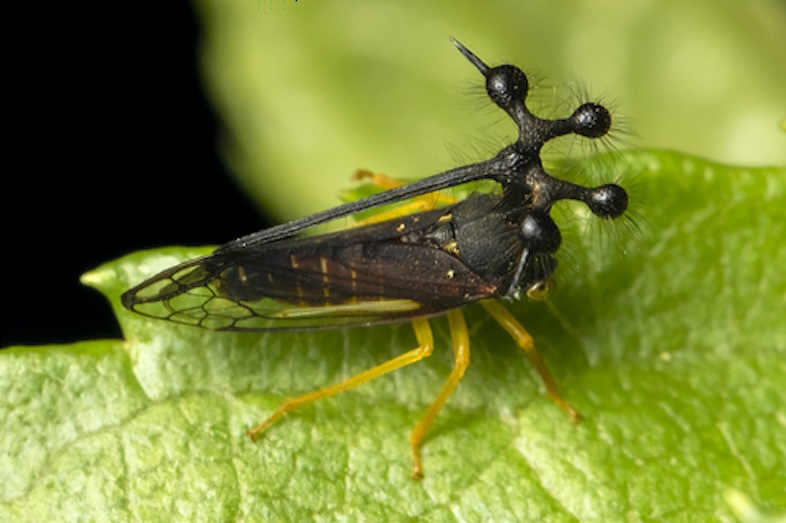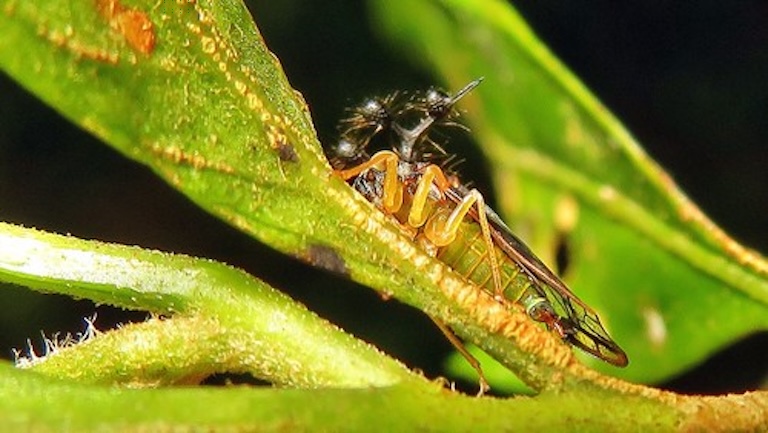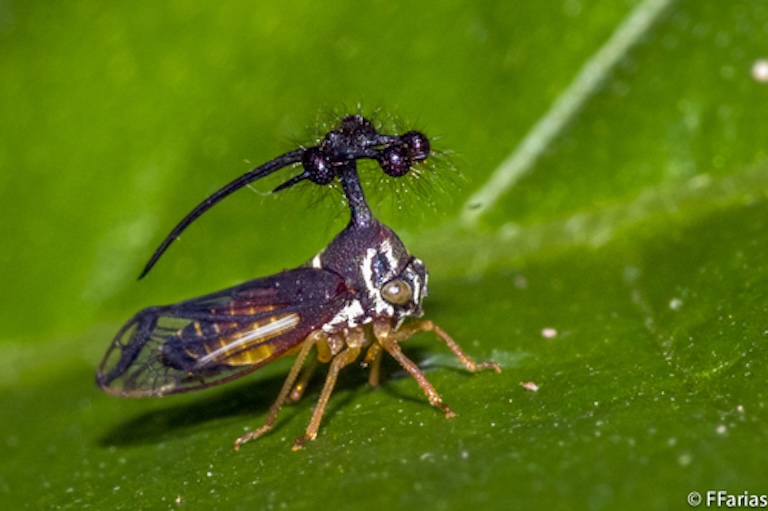Brazilian Treehopper Profile
Despite what “A Bug’s Life” might have you believe, most insects are not bugs. True bugs are a single, yet highly diverse order of insects defined by their piercing mouthparts and unique wing structure.
Among them are the pesky bedbugs, who use their mouthparts for evil, and the vegetarian cicadas, who create the deafening soundscape in many warm, wooded areas.
Like the cicadas, the treehoppers are plant-feeders, but instead of weird noises, they have weird heads. The Brazilian treehopper, whose name offers no clues to its weirdness, is one of the more unusual of this group.

Brazilian Treehopper Facts Overview
| Habitat: | Plant leaves |
| Location: | South and Central America |
| Lifespan: | Unknown |
| Size: | Around 1 cm (0.4 in) |
| Weight: | <1g |
| Colour: | Dark brown/black with orange-yellow legs |
| Diet: | Plant fluids |
| Predators: | Ants, wasps, birds, reptiles |
| Top Speed: | Mostly sedentary |
| No. of Species: | 1 |
| Conservation Status: | Not Listed (IUCN) |
The Brazilian treehopper is a small insect that moves rarely and spends much of its life feeding on fluids from beneath leaves in the forests of Central and South America.
This life is a slow one, but there are potential predators that can shake it up.
Perhaps in self-defense, or perhaps for some other, yet-unknown reason, this species has developed an intricate, bulbous protrusion that extends up from its thorax like an animated Beetlejuice sculpture.
These appendages are peculiar and distinctive, but nobody is sure what they’re for.
Interesting Brazilian Treehopper Facts
1. They’re bugs
The Hemipteran order contains the true bugs, and within it, there are around 135 families, some more similar than others.
Treehoppers make up the families Membracidae and Aetalionidae and are very similar in appearance to their close relatives, the leafhoppers and cicadas, and usually somewhere in between the two in size.
Many of this cluster of families exhibit very strange and unique attributes that aren’t found in other animals. For the treehoppers, their uniqueness manifests in a weird extension of the body—something that many species within the family present with, but few as strangely as the Brazilian treehopper.

2. They have weird appendages
Like so many of their kind, the Brazilian treehoppers have a modified appendage of their own, unique to the species. It extends up from the thorax region and has rounded balls at the end of it that look a lot like eyes.
It’s not as colorful as is found in other species, but in terms of structure, it’s one of the most intricate. What it’s for, though, is still a question nobody can answer. 1
3. Nobody’s sure why
The purpose of this extended and very specific growth has been a matter of debate for as long as leafhoppers have been known to science.
When animals have something weird growing on them (that they’re supposed to have), the first thought is that it’s a sex thing.
Animals of all kinds show off their fitness in weird ways, and often, as Nicki Minaj can attest to, the bigger something is, the more desirable it is to a mate.
But this sexually selected process is usually evident when the trait is only present in one sex, and in treehoppers, both males and females have them.
Other ideas include self-defense, sensory organs, camouflage, or communication devices, all of which come with their own testable hypotheses and, in this species, at least, have yet to be fully eliminated as options.
The presence of spines supports the idea that this could be a defensive organ, but why it’s covered in balls is a bit of a mystery. 2
4. They were thought to be a third pair of wings
Originally, this growth was determined to be a modification of a thoracic plate called the pronotum, which is a modification seen in many other insects and therefore would not be all that surprising, but one researcher discovered what appeared to be joints at its base and concluded that this was evidence of a third set of wings that fuse together in the insect’s development and grow outward into the bizarre structure.
However, this idea hasn’t stuck, and further research has refuted this new claim, citing errors in the assessment of the paper’s author.
This is essentially the peer-reviewed equivalent of a He said, she said situation, but the refutation seems credible and also points to various mistakes in the wing hypothesis, backing it up with detailed explanations.
But back to what we do know. 3 4

5. Ants eat their poo
Treehoppers are fluid-feeders, jabbing their sharp mouthparts into their host plants and sucking out the juices. This juice has a lot of sugar but very little protein, so to get their nitrogen requirements met, they need to drink a lot of it.
The result is a high amount of waste sugar, which comes out of the butt of the treehopper as concentrated honeydew.
Various species of ants and bees are drawn to this liquid, which can even be flicked from the butt to the forest floor in order to attract them.
While wasps and flies will come and feed on the delicious butt water, only ants appear to stick around and provide something in return.
Many treehopper species have specific ant species that have evolved to form a mutually beneficial relationship with them: they provide the sugary food and the ants provide a safe haven for the treehoppers to eat.
Brazilian Treehopper Fact-File Summary
Scientific Classification
| Kingdom: | Animalia |
| Phylum: | Arthropoda |
| Class: | Insecta |
| Order: | Hemiptera |
| Family: | Membracidae |
| Genus: | Bocydium |
| Species: | globulare |
Fact Sources & References
- “Meet The Brazilian Treehopper”, Heads Up.
- “The Brazilian treehopper is the creepiest, raddest insect you will ever see”, Grist.
- “Treehoppers”, The Smaller Majority.
- István Mikó (2012), “On Dorsal Prothoracic Appendages in Treehoppers (Hemiptera: Membracidae) and the Nature of Morphological Evidence”, Plos One.
